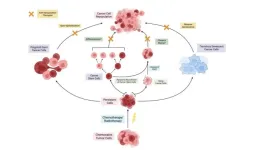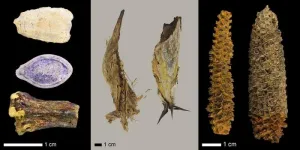(Press-News.org) NEW YORK, NY--The cause of a common kidney disease likely lies outside the kidney, according to a new study led by Columbia University researchers. The study, which uncovered 16 new locations in the genome linked to immunoglobulin A (IgA) nephropathy, confirms an earlier hypothesis that the immune system has an important role in driving the disease and points toward new strategies for detecting and treating it.
No targeted treatments have been approved to treat IgA nephropathy, largely because the underlying cause of the disease has not been well understood.
Identifying genes linked to a disease can provide clues to its source and guide the development of new drugs, but thousands of patients are needed for such studies. For IgA nephropathy, those numbers are difficult to achieve.
Though common compared to other forms of kidney disease related to the immune system, IgA nephropathy is hard to diagnose, and confirmed patients are difficult to find. “The diagnosis requires a kidney biopsy, which is an invasive procedure that carries a lot of risks, so the diagnosis is frequently missed,” says Krzysztof Kiryluk, MD, associate professor of medicine at Columbia University Vagelos College of Physicians and Surgeons and lead author of the study.
Kiryluk and his colleagues tackled the numbers problem by building a vast network of collaborators, eventually including nephrologists, geneticists, and other scientists scattered across four continents. Each collaborator recruited biopsied patients locally and sent blood samples to Kiryluk’s Columbia team for DNA extraction and analysis.
With samples from almost 40,000 subjects, the researchers compared DNA from IgA nephropathy cases to DNA from people who do not have the disease. The study, which took 10 years to complete and involved nearly 200 scientists and clinicians at more than 100 institutions, is the largest ever of the genetics of IgA nephropathy.
Many of the new genes identified in the study are involved in the production of IgA antibodies, reinforcing the idea that regulation of IgA levels is the key factor behind the disease.
“That’s a very important finding because IgA nephropathy is considered to be a kidney disease, but it seems like its source is outside the kidney,” says Kiryluk.
“We also developed a genetic risk profile that may help identify patients at highest risk of progression to kidney failure,” says Ali Gharavi, MD, the Jay Meltzer, MD, Professor of Nephrology and Hypertension and co-leader of the study.
The researchers also identified proteins produced by the newly identified genes that look like the best targets for drug development. And they identified two drugs already studied for other conditions that may have potential as IgA nephropathy treatments.
“A recent analysis found that drug targets backed by genetic studies are more likely to succeed,” Kiryluk says, “and we hope that pharmaceutical companies will start developing new therapies based on our findings.”
More information
The study, titled “Genome-wide association analyses define pathogenic signaling pathways and prioritize drug targets for IgA nephropathy(link is external and opens in a new window),” was published in Nature Genetics on June 19.
All authors and institutions are included in the article.
The study was supported by the National Institutes of Health (R01-DK105124, RC2-DK116690, R01-DK082753, R01LM013061, U01HG008680, U01AI152960, R01-DK078244, R01-AI149431, R01HG010730, U01AI130830, R01NS099068, R01AI024717, R01AR073228, U01AI150748, R01AI148276, P01AI150585), IGA Nephropathy Foundation of America, and others.
Ali Gharavi has served on an advisory board for Novartis, Travere, and Natera and receives research grant funding from the Renal Research Institute and Natera. Krzysztof Kiryluk has served on an advisory board for Goldfinch Bio and Gilead. Additional disclosures are found in the article.
END
Source of common kidney disease lies outside the kidney, study suggests
2023-06-23
ELSE PRESS RELEASES FROM THIS DATE:
Stanford Medicine-led research identifies a subtype of depression
2023-06-23
Scientists at Stanford Medicine conducted a study describing a new category of depression — labeled the cognitive biotype — which accounts for 27% of depressed patients and is not effectively treated by commonly prescribed antidepressants.
Cognitive tasks showed that these patients have difficulty with the ability to plan ahead, display self-control, sustain focus despite distractions and suppress inappropriate behavior; imaging showed decreased activity in two brain regions responsible for those tasks.
Because depression has traditionally been defined as a mood disorder, ...
Stanford University’s Innovative Medicines Accelerator and Intonation Research Laboratories form a collaboration to fight cancerous neuroendocrine tumors
2023-06-23
Stanford University’s Innovative Medicines Accelerator (IMA) and Intonation Research Laboratories (Intonation) have formed a collaboration to develop treatments that target cancerous neuroendocrine tumors, or tumors that form from hormone-releasing cells.
The goal of the collaboration is to reduce the time and resources it takes to translate a biomedical breakthrough into a clinically and commercially viable medicine.
“I’m excited about this collaboration with Intonation Research Laboratories, which has the potential to speed ...
Extinct warbler’s genome sequenced from museum specimens
2023-06-23
The Bachman’s warbler, a songbird that was last seen in North America nearly 40 years ago, was a distinct species and not a hybrid of its two living sister species, according a new study in which the full genomes of seven museum specimens of the bird were sequenced. Genome comparisons of Bachman’s warbler with the golden-winged and blue-winged warblers also helped researchers identify a new candidate gene involved in feather pigmentation in the group. A paper describing the study, led by Penn State researchers, highlights the crucial role that museum collections can play in science and appears ...
Baylor researchers examine relationship between imprisoned mothers and their adolescent children’s risk behaviors
2023-06-23
WACO, Texas (June 23, 2023) – Women represent the fastest-growing population in U.S. institutional corrections facilities. In the past four decades, the number of women incarcerated has increased by more than 475%, rising from 26,326 in 1980 to 152,854 in 2020.Because the majority of imprisoned women are mothers, a conservative estimate indicates that at least one million American children have experienced maternal incarceration, and a substantial portion of them are adolescents.
Evidence suggests that maternal incarceration is a risk factor for adolescents’ ...
NSF CAREER Awardee develops a 1-minute frailty testing platform
2023-06-23
A layperson might think of “frail” as simply a synonym for “weak” or “fragile.” But in the medical field, frailty is a specific term, meaning – due to factors including inflammation and hormone shifts – a patient has a lack of physiological reserve, or a reduced ability to tolerate stress.
“That stress can be anything from the simple event of falling to getting COVID or another infectious disease,” said Nima Toosizadeh, assistant professor of biomedical engineering and medicine. “Or, it can be a treatment that might be invasive for patients. Knowing who can tolerate the stress is critical.”
It ...
Cancer cell repopulation after therapy: which is the mechanism?
2023-06-23
“Approaches targeted to prevent this post-therapy cancer cell repopulation should be uncovered to prevent tumor relapse and thus increase overall survival from this devastating disease.”
BUFFALO, NY- June 23, 2023 – A new research perspective was published in Oncoscience (Volume 10) on June 1, 2023, entitled, “Cancer cell repopulation after therapy: which is the mechanism?”
The past two decades have brought great progress in the treatment of cancer as patients with the disease live ...
Mario Romero-Ortega to lead Biomedical Engineering at the University of Arizona
2023-06-23
Mario Romero-Ortega was selected through a nationwide search to head the University of Arizona Department of Biomedical Engineering, beginning with the fall 2023 semester.
“I was drawn by the culture of collaboration, the quality of the students and faculty, and by the unified vision from University of Arizona leadership to impact biomedical engineering and health, from local to global,” he said.
Romero-Ortega will join the College of Engineering from the University of Houston, where he serves in the College of Engineering as a Cullen ...
When majority men respect minority women, groups communicate better
2023-06-23
Kyle Emich, a professor of management at the Alfred Lerner College of Business and Economics, along with Rachel Amey and Chad Forbes, then with UD’s Psychology and Brain Sciences Department, were searching for clues about why women’s knowledge often gets ignored in the workplace and how to improve the situation.
Drawing on both a problem-solving group exercise and measurements of brain activity, their findings, now published by the journal Small Group Research, illustrate ways stereotypes and attitudes can ...
Lessons in sustainability, evolution and human adaptation — courtesy of the Holocene
2023-06-23
The El Gigante rockshelter in western Honduras is among only a handful of archaeological sites in the Americas that contain well-preserved botanical remains spanning the last 11,000 years. Considered one of the most important archaeological sites discovered in Central America in the last 40 years, El Gigante was recently nominated as a UNESCO World Heritage site.
“No other location shows, as clearly as El Gigante,” state UNESCO materials about the site’s universal value, “the dynamic character of hunter-gatherer societies, and their adaptive way of life in the Central ...
New study reveals global reservoirs are becoming emptier
2023-06-23
Water is an essential and indispensable component of humanity’s everyday existence. As the global population grows and the climate warms, so does the water demand.
Over the past two decades, global reservoirs have become increasingly empty despite an overall increase in total storage capacity due to the construction of new reservoirs.
Led by Dr. Huilin Gao, associate professor in the Zachry Department of Civil and Environmental Engineering at Texas A&M University, researchers used a new approach with satellite data to estimate the storage variations ...




